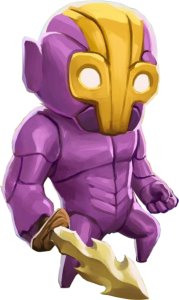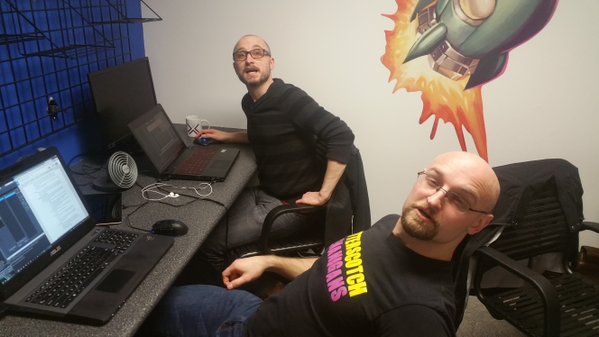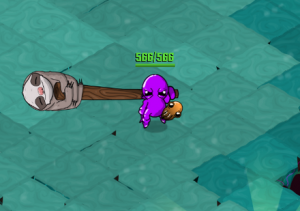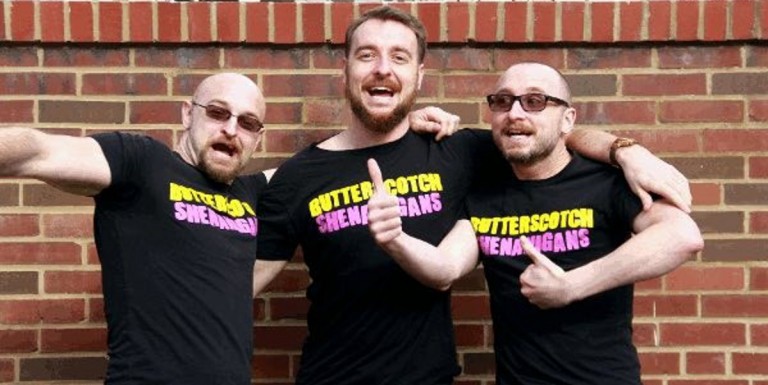We’ve always been big fans of Butterscotch Shenanigans here at iFanzine, but the recent release of Crashlands took our admiration to a new level. So we jumped at the opportunity to fire some questions at one of the indie studio’s co-founders/developers, Sam Coster (pictured above in the middle). Here’s what he had to say:
Congratulations on finally releasing Crashlands, it was a positively amazing adventure that I hope all our readers will eventually check out! So I’ve read that the key staff over at Butterscotch Shenanigans are all actually brothers, meaning it’s little mystery as to how everyone first met. However, what I’d like to know is how did you all come to realize your dream goal was to one day make such amazing — yet also weird — games together?
Seth had always wanted to make games, while Adam and I had shelved the idea as too far fetched for our skillsets and where we grew up. Being from the middle of Iowa, we’d had only cursory opportunities to learn programming, so it always seemed out of reach.
I graduated with a degree in Psychology while Seth got one in Finance, and Adam was waist deep in a Molecular Bio PhD. We had more or less given up on the idea of being able to make games, and went about our lives without thinking about it as an option.
Then we did some St. Louis game jams. They’re these 48 hour weekend events where you get a theme and then have to build a game based on it by Sunday evening. After doing our first one this lightbulb went off and we sat back and said — “Oh s***. We could DO this!”
Speaking of origin stories, how did your talented triumvirate eventually decide upon your rather unique company name: Butterscotch Shenanigans? I’d imagine there must have been quite the story behind a name that’s as equally offbeat as your various games.
At the time of the studio’s creation, Adam was still in the midst of his PhD. We wanted an umbrella company that could be used to sell whatever stuff we wanted to make — games, at the time, were just one part of that. Adam was interested in building apps for labs. So we chose Shenanigans as an encompassing term that could easily hold all of our activities. Butterscotch was the result of a ridiculously long car ride. It sounded so good in conjunction with Shenanigans that it just kind of stuck.

One item that interested me in Crashlands was how it tied together all the various plots and concepts from your previous efforts. Had it always been your starting plan for these various ideas to all be part of one gloriously demented universe, or was this an opportunity that merely presented itself during the course of Crashlands’ development?
It was something we’d always hoped to do, but until Crashlands we didn’t have a game that was hefty enough to support it. To be able to tie in the characters and activities from 4 other games which, at their conception, weren’t actually tied together, required quite a bit of game space! We retconned everything to work, and now view the universe we’re building as our core offering, besides the games themselves. It’s a crazy place.
My favorite feature of Crashlands — however — had to be the absolute interoperability between the various versions, including the PC release made available through Steam’s Marketplace. While I enjoy playing games on my iPod Touch when travelling, I’d ideally rather use something like my computer — or a proper game console — when I’m back at home. Now that your Butterscotch ID system is finally in place, are you potentially planning on going back and releasing any of your previous games — such as the amazing Quadropus Rampage — on Steam as well?
We’ve talked a lot about bringing QR to Steam. Towelfight 2 actually got through Greenlight and is just sitting there, awaiting a launch. However, we can’t bring ourselves to do it, as neither of those games was actually designed for those platforms. We want our studio to become synonymous with ridiculous fun and quality, and for what we can produce now it doesn’t feel like either of those games could deliver like we want them to on PC!
 Many people in the field of game development have argued whether proper development should first begin with mechanics (and afterwards making a story to fit the game play), or with a solid story locked-in first (with the mechanics then designed to serve the plot). Crashlands is just as much fun to play as it was to follow the demented plotline stringing along Flux’s quest to eventually escape from planet Woanope, and I ultimately find myself wondering which aspect of all this that Butterscotch Shenanigans tackled first?
Many people in the field of game development have argued whether proper development should first begin with mechanics (and afterwards making a story to fit the game play), or with a solid story locked-in first (with the mechanics then designed to serve the plot). Crashlands is just as much fun to play as it was to follow the demented plotline stringing along Flux’s quest to eventually escape from planet Woanope, and I ultimately find myself wondering which aspect of all this that Butterscotch Shenanigans tackled first?
Mechanics, for sure. We have a hardline stance on this because the one thing players get from games that they can’t get from other media is the play experience. It’s the core of this form of media, so we always start there. We actually wrote the story in about 3 months right before going into Beta (August-November-ish).
Another example of this — Pete, the villain in Quadropus Rampage, was added 3 days before launch. We realized we needed a point to the whole BEATING EVERYTHING IN THE OCEAN game, so we just shoved it in there!
It’s additionally been said that a major factor of stellar game design is to implement something, and then afterwards build something better once you’ve figured out why your initial idea wasn’t quite performing as desired. Other than the shift in development towards your new Butterscotch ID system, was there anything of noteworthiness in Crashlands that — for various reasons — simply didn’t survive to the game’s final release?
Ha! Oh yes. So many things.
There was a taming mini-game all the way up until the last 6 months of dev. You had to knock a creature out and then throw the taming item (now the creature catalysts) at it, like a Pokeball. Then this little arrangement of hearts came up and you had to quickly match them to win over the beast or it would become enraged and try to murder you.
We did have inventory for quite a long time. And block-wise placement of items (no buildmode). And creature-crossfire, which turned the game into a warzone (wompits stomping each other, glutterflies launching tactical artillery strikes on one another, etc).
We threw out probably twice as many things as went into the game.

Although I know there’s already a ton of “Quality of Life’ improvements — meant to spruce up Crashlands’ future — currently in the pipeline, are there any major content updates — such a new side quests, or perhaps even a new biome — planned for the future?
The biggest update we have planned is the Creator. The Creator is the web-based backend that we used to write and program the story. We’re turning that over to the community, so you could go in and write your own stories, create your own characters and outposts, even reprogram the bosses in various ways. Then we’re adding mutators to it, so you could potential have permadeath, turn that creature cross-fire feature back on, convert the game into an RPG, all sorts of stuff.
Players can download one another’s campaigns from within the game (on any platform) and vote on one another’s stories. It essentially will turn Crashlands into a constrained game engine.
Once that wraps we’re going to get started on the next project and take our first crack at multiplayer, which should be fun. We’ll revisit Crashlands from time to time — it’s got a special place in our studio.
Additionally, are you currently intending to go back — as a result of your new Butterscotch ID system — and add extra unlockable tie-in content to Crashlands whenever your next game arrives?
YEP. We added an email to the BSID system that lets players know about the perks and explains how the cross-game content works. Since we did that we’ve seen a huge uptick in people hunting down the achievements in other games and then coming back to do the questlines they unlock in Crashlands, and the response has been great. Fans love it, and we love that they love it, so there will always be stuff like that going on.
 Speaking of your Butterscotch ID system, it didn’t yet exist when we initially covered Quadropus Rampage (but that game — alongside everything else — has since been retrofitted to take advantage). When did you realize that you no longer wanted to use the mobile market’s mainstay system of micro-transactions, and instead go with a business model more akin to the one that launched John Carmack’s legendary DOOM to stardom?
Speaking of your Butterscotch ID system, it didn’t yet exist when we initially covered Quadropus Rampage (but that game — alongside everything else — has since been retrofitted to take advantage). When did you realize that you no longer wanted to use the mobile market’s mainstay system of micro-transactions, and instead go with a business model more akin to the one that launched John Carmack’s legendary DOOM to stardom?
There’s a big problem with the mobile market in general, which is that it’s hard to develop much of a following. Games that are free don’t tend to stick with their players much, because they require no buy-in and tend not to treat the player as much more than a money pinata (in general, there are, of course, great games that fit the model perfectly). We wanted to break away from the launch-dependency we’d experienced with our first few games and try to get our own fan system built that let us really cultivate an audience. That’s where BSID comes in. Its existence is actually why we were comfortable launch Crashlands as a pay-upfront title. It gave us confidence that we could reach the people who would probably care, without any reassurance from the platforms themselves.
We’ll likely be doing pay-upfront forever. Some game types fit a F2P model much better than a pay-upfront one (lots of multiplayer games, card games, tiny arcade games, etc), so it’s not that we won’t use it, just that we’ve found the freedom to do really big, crazy projects that simply would break under the strain of F2P monetization.
It’s a lovely feeling.
By the way, as a developer whom has already launched a large number of well received mobile games — such as Crashlands, Quadropus Rampage, and Towel Fight 2 — what advice does Butterscotch Shenanigans have for budding indie mobile developers?
Each game you launch is a tool you can use to further your studio. Don’t count on the first, second, third, or even fourth game accomplishing the goal of MAKIN’ CASH MONIES, because it’s exceptionally unlikely, especially if that’s the only goal you have in mind.
Break that big goal — making enough money to live — into its smaller parts. First, you need to build an audience. Free-to-play titles are great for this. Then, you need to impress the platforms. Use of their tech or uniquely situated games are great for this. Lastly, you need to perform a mic drop — bring something to the platform that’s new, huge, innovative, ridiculously goodlookin’, or just plain weird so that people can’t help but pay attention. Once you’ve got an audience, platform buy-in, and a unique product the rest will sort itself out.
Don’t count on all that happening on your first go. That’s a silly amount of pressure to put on any given game. You’re going to need to be able to do this for 3-5 years before you can expect any sort of payoff. 2/3rds of our studio weren’t being paid until Flop Rocket launched (2 years into the studio). The other 1/3rd was being paid far below poverty level.
Strap in, gather your friends and family close and get them to buy-in on your dream. You’ll need a tribe to get it done.

Finally, is there any possible information you could share with iFanzine regarding Butterscotch Shenanigans’ next big mobile-gaming project (perhaps something potentially featuring the super-iconic “Gerrymandering Pistol-Whip of Iowa”)?
Oh how we loved that Pistol-whip. I can’t say exactly what it will be, but we’re aiming to do some lightweight multiplayer (not real-time action, but something cool) on top of a Polari war story. The game NARWHAL ONLINE, which we made for the St. Louis Scatterjam a few years back, may end up having something to do with it.
I’VE SAID TOO MUCH! I MUST AWAAAAY!
A massive thank you for such a fascinatingly in-depth interview, Sam!


